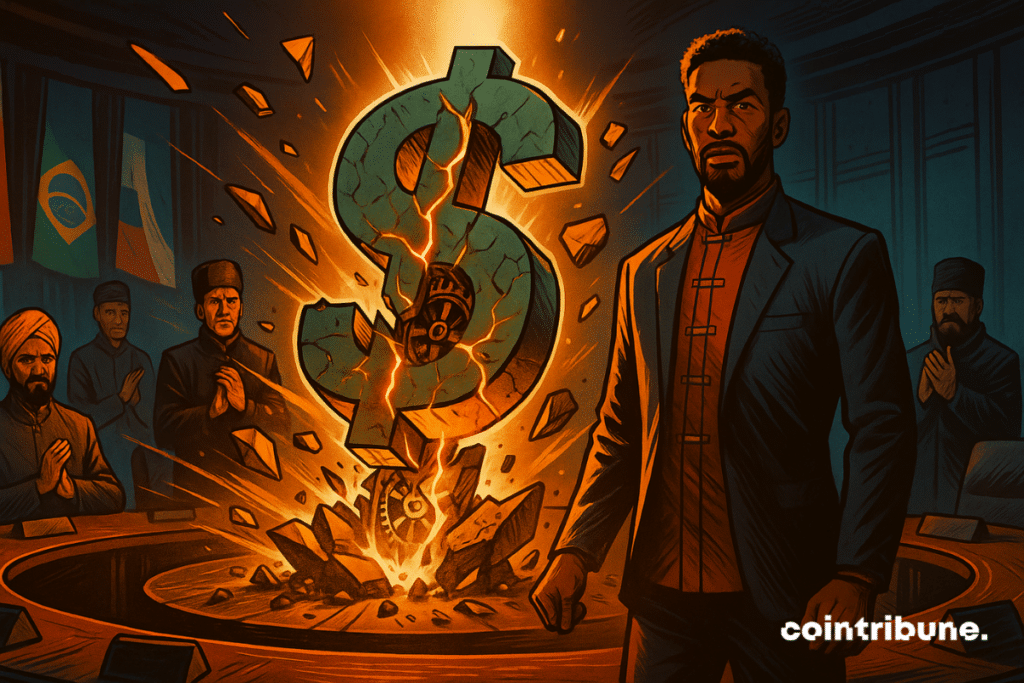7h05 ▪
5
min read ▪ by
A quiet but massive shift is redefining global monetary balances. Indeed, over 90 countries, led by the BRICS, are abandoning the dollar in their international trade. In its place, the yuan, the ruble, or the rupee are gradually becoming dominant. This strategic realignment, far from a mere technical adjustment, challenges the financial order built around the United States since the post-war era. A deliberate desire for economic sovereignty and a direct challenge to American hegemony over global flows are at the heart of this movement.

In brief
More than 90 countries have initiated a historic break with the US dollar in their international trade.
Entire regions, like the Commonwealth of Independent States, Africa, and ASEAN, join the movement by adopting their own currencies in international trade.
The United States reacts firmly, notably with threats of trade sanctions brandished by Donald Trump.
Despite tensions, dedollarization appears to be a lasting trend, perhaps signaling a new global monetary balance.
The BRICS Lead the Global Dedollarization
Since the beginning of 2025, BRICS members have intensified their dedollarization strategy with concrete actions such as transitioning to local currencies. This momentum is based on a shared desire to restore a form of monetary sovereignty in international exchanges.
Mohammad Reza Farzin, governor of the Central Bank of Iran, stated :
We have concluded a monetary agreement with Russia and have completely eliminated the US dollar. We now trade exclusively in rubles and rials.
Similarly, trade between India and Russia has increased from 13 to 27 billion dollars thanks to the adoption of rupee payments. As for Brazil, it has established direct exchanges between the real and the yuan with China, supported by the integration of the Chinese payment system into Brazilian banking institutions.
Beyond bilateral agreements, the BRICS are setting up dedicated financial infrastructures capable of competing with Western systems. Several operational mechanisms embody this strategy:
BRICS Pay, a cross-border payment system in local currencies, already enables more than 50 partner countries to bypass SWIFT ;
The Commonwealth of Independent States (CIS), associated with the BRICS, now conducts 85 % of its cross-border transactions in national currencies ;
The New Development Bank (NDB) finances infrastructure projects in local currencies, like in Brazil (1,041 million BRL) or Russia (68.8 million USD) ;
The ruble has risen from 10 % to more than 40 % of Russian exports, a leap made since sanctions related to the conflict in Ukraine.
These elements show that dedollarization is no longer mere political rhetoric. It is embedding itself into the very mechanics of international economic exchanges, driven by concrete tools, deliberate political decisions, and increasing regional coordination.
A Momentum That Far Exceeds the BRICS Circle
Beyond the initial circle of BRICS, the dedollarization movement is spreading to many countries in Africa, Asia, and the former USSR. The Commonwealth of Independent States (CIS), which includes Armenia, Azerbaijan, Belarus, Kazakhstan, and Uzbekistan among others, now performs more than 85% of its cross-border transactions in local currencies.
Africa is not left behind. For example, Tanzania has officially banned the dollar in certain transactions, paving the way for countries like Kenya and Nigeria to adopt sovereign currency payment models in turn. ASEAN, for its part, actively promotes regional mechanisms for settlements in local currencies.
One of the sectors where this shift is most evident is energy. Saudi Arabia, now aligned with the BRICS, accepts the yuan for its oil sales, while India pays its Russian imports in rupees, bypassing the dollar.
Ghana has chosen to use gold for its crude imports. These movements are often interpreted as a response to the political use of the dollar. Vladimir Putin summed it up this way: “The dollar is used as a weapon. We really see that this is the case. It is a serious mistake.”
Faced with this momentum, the United States’ response was immediate. Donald Trump threatened to impose 100% tariffs on nations involved in establishing monetary alternatives. These threats have already had political effects.
In Brazil, President Lula removed the idea of a common currency from this year’s BRICS Brazilian presidency agenda. “Resorting to unilateralism undermines the international order. In the face of polarization, a coherent defense of multilateralism is the only path forward,” he nonetheless declared, marking a balanced stance.
However, the momentum seems firmly underway. Dedollarization is no longer just a protest; it is now a global strategic pivot, as evidenced by numerous initiatives aiming at reducing dependency on the dollar. It remains to be seen whether this monetary transformation will lead to a lasting rebalancing of economic power or only reinforce the geopolitical fragmentation already at play.
Maximize your Cointribune experience with our “Read to Earn” program! For every article you read, earn points and access exclusive rewards. Sign up now and start earning benefits.
Diplômé de Sciences Po Toulouse et titulaire d’une certification consultant blockchain délivrée par Alyra, j’ai rejoint l’aventure Cointribune en 2019.
Convaincu du potentiel de la blockchain pour transformer de nombreux secteurs de l’économie, j’ai pris l’engagement de sensibiliser et d’informer le grand public sur cet écosystème en constante évolution. Mon objectif est de permettre à chacun de mieux comprendre la blockchain et de saisir les opportunités qu’elle offre. Je m’efforce chaque jour de fournir une analyse objective de l’actualité, de décrypter les tendances du marché, de relayer les dernières innovations technologiques et de mettre en perspective les enjeux économiques et sociétaux de cette révolution en marche.
DISCLAIMER
The views, thoughts, and opinions expressed in this article belong solely to the author, and should not be taken as investment advice. Do your own research before taking any investment decisions.




